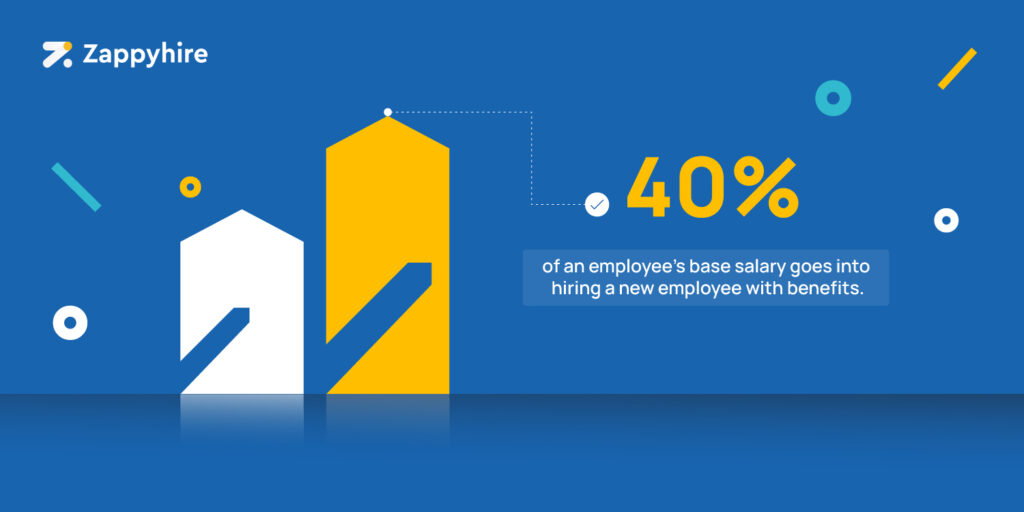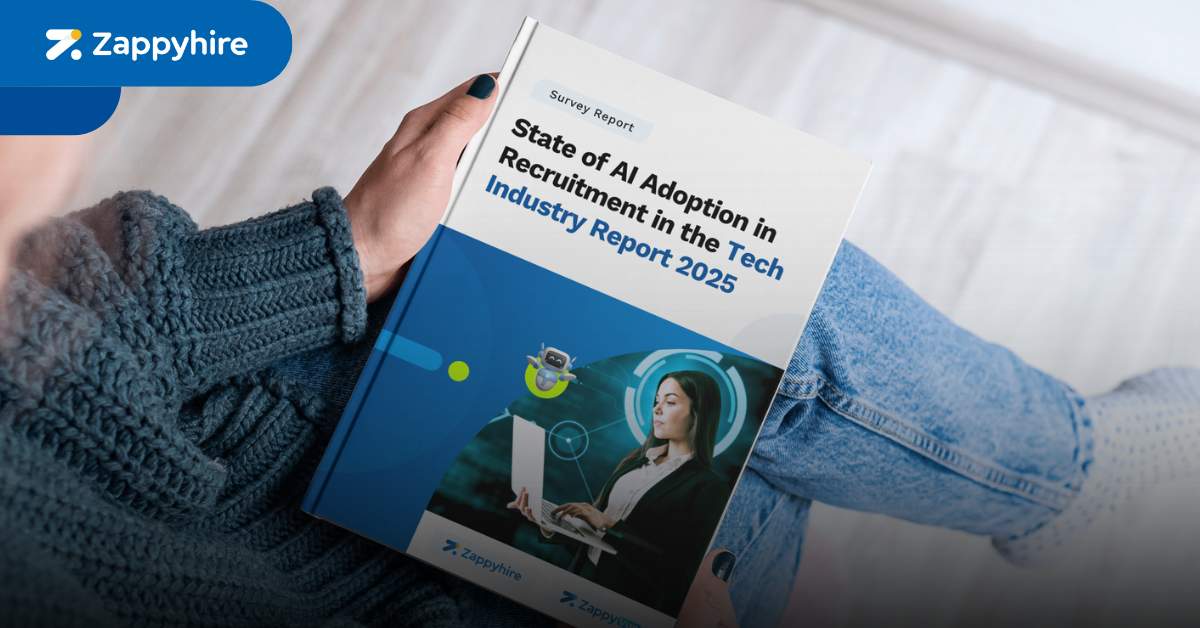
Nailing talent acquisition and retention is the key to organizational triumph – and the responsibility does NOT fall on your recruitment team alone.
While HRs and recruiters usually keep an eye on the recruiting metrics, it’s time for you as a business leader to step into the game.
As Deepu Xavier, Co-Founder of Zappyhire, rightly puts it,
“While recruiters focus on tracking KPIs to optimize their transactional activities, leaders should leverage insights derived from these KPIs to make more strategic decisions.”
So, what are KPIs in recruitment?
KPI stands for Key Performance Indicators, and they’re like your trusty compass in the hiring journey. These nifty metrics help you measure and evaluate the success of your recruitment efforts.
Presented in various forms like ratios, percentages, single numbers and other formats, recruitment KPIs provide a comprehensive snapshot of the Talent Team’s recruitment efforts.
They let you know what’s working and what might need a little tweak. Are you finding the right candidates? Are they sticking around once they’re hired? How long does it take to bring someone new on board?
KPIs give you answers to all these questions and more.
Whether you’re a business leader steering the ship or a recruiter navigating the waters, KPIs help you work together, stay on course, and make hiring decisions that lead to smooth sailing.
As Deepu Xavier further emphasizes,
From diversity to time to hire, tracking KPIs are essential for achieving process maturity in recruitment. Without measurable data, organizations cannot optimize their efforts or foster a more inclusive and efficient hiring process.
What are the most important recruiting KPIs?
Tracking these key performance indicators (KPIs) in the recruitment process gives you valuable insights into your workforce’s health, possible threats, and areas for improvement.
This includes key insights like – cost per hire, yearly employee turnover rate, and much more, which impacts the overall business productivity.
So, are you ready to dive in? Let’s explore the top recruitment KPIs that you must track as a business leader to ensure hiring success.
1. Employee Turnover Rate
We’ve all been there – the dreaded employee turnover.
It’s a red flag that something might be amiss with recruitment, onboarding, company culture, or employee satisfaction. By keeping tabs on this hiring metric, you gain insights into potential problem areas.
High turnover disrupts operations, saps productivity, and inflates recruiting, training, and knowledge transfer costs.
Experiencing even minor rates of employee turnover can lead to substantial financial implications for the organization on a company-wide scale.
For instance, in a hypothetical 100-person company with an average annual salary of $50,000, the costs associated with turnover and replacement could amount to a staggering $2.6 million annually.
So, analyzing turnover rates helps you identify trends, diagnose issues, and implement strategies to boost retention, amp up employee engagement, and keep your business humming.
2. Time-to-Fill Key Positions
Here’s a scenario:
You have key roles waiting to be filled, and time is of the essence. Tracking the time it takes to fill these critical positions is crucial for seamless business operations and avoiding productivity gaps.
Prolonged vacancies can throw a wrench into your plans, delay projects, and leave customers grumbling.
No bueno! Monitoring time-to-fill helps you identify recruitment process hiccups and talent pipeline issues. For reference, the average time-to-fill is 41 days.
Armed with this knowledge, you’ll make data-driven decisions to optimize recruitment strategies and secure the right talent to propel your business forward.
3. Cost of Vacant Positions
Vacant positions are like money down the drain. Ever wonder just how much those vacancies cost your business?
Calculating the cost gives you a full picture of the financial implications. Think lost productivity, project delays, overtime expenses, and revenue impact. Ouch!
Tracking this recruitment metric lets you prioritize hiring efforts, allocate resources smartly, and make informed decisions to minimize financial hits.
Lessen the cost of vacant positions, and you’ll enhance operational efficiency, keep customers happy, and unlock your business’s true potential.
4. Quality of Hire
Building a strong and reliable workforce is at the heart of any successful business, isn’t it?
Yet, it’s no longer sufficient for your HR team to merely plug roles; the emphasis has shifted towards the calibre of your recruits.
The quality of hire metric emerges as a potent tool, enabling a profound evaluation of the influence and effectiveness of newly onboarded employees.
This metric transcends the surface-level metrics and dives into the depths of performance and potential,
but how do we grasp and quantify the elusive “quality” in hires?
It’s a blend of factors that intertwine to paint a comprehensive picture.
Factors such as swift adaptation to roles, alignment with your organization’s culture and values, and their ability to seamlessly mesh with existing teams showcase the quality that each hire brings.
Moreover, the impact they have on team dynamics, innovation, and productivity is equally pivotal.
Their capacity to learn and grow within the company, their contribution to a harmonious work environment, and their propensity to take the initiative all play into understanding the true quality they imbue.
5. Revenue per Employee
Let’s talk about productivity and efficiency.
Tracking revenue per employee gives you insights into how well your workforce is doing. Are you maximizing their potential to drive profitability?
To determine your company’s revenue per employee, simply divide the total revenue of the company by the current number of employees.
Revenue per Employee = Total Revenue / Number of Employees
A high revenue per employee is music to your ears, indicating that your business is firing on all cylinders. On the flip side, a low revenue per employee may mean there are snags in talent acquisition, training, or skill alignment.
Analyzing this KPI in the hiring process reveals areas for improvement, helping you fine-tune your workforce, boost productivity, and set the stage for revenue growth.
6. Talent Acquisition Cost
AKA cost-to-hire, finding and hiring top-notch talent requires investments. Want to know just how much it’s costing you?

Add up your internal recruiting costs and external recruiting costs and then divide this total by the number of hires made within a specific time frame. In short, to calculate CPH (Cost Per Hire), you can use the following formula:
Cost-per-hire = Total recruitment cost / Total number of hires
Tracking the overall cost of hiring new talent gives you a clear view of the investment needed to attract and hire the best. Recruitment marketing expenses, agency fees, technology platforms, and internal resources all come into play.
Smart decisions about budget allocation and recruitment operations will maximize the value of your talent acquisition investments and ensure you’re getting the most bang for your buck.
7. Succession Planning Effectiveness
Ah, the future! Succession planning is essential for business longevity. That’s why tracking metrics like internal promotion rates, bench strength, and successor readiness is crucial.
Keep an eye on leadership pipelines, spot potential skill gaps, and identify development opportunities.
Effective succession planning ensures smooth transitions, minimizes risks from talent gaps, and fosters a culture of growth.
8. Diversity and Inclusion Impact
At its core, diversity and inclusion encompass a comprehensive approach that extends far beyond surface-level representation.
Diversity encompasses a range of characteristics such as gender, race, age, ethnicity, sexual orientation, physical abilities, and more, creating a rich tapestry of perspectives.
Inclusion, on the other hand, addresses the active involvement and empowerment of all individuals within an organization, irrespective of their backgrounds.
It ensures that each voice is not only heard but valued, fostering a sense of belonging and respect.
In short, diversity and inclusion are the twin engines that power progress. Embracing diversity and inclusion fuels innovation, employee engagement, and overall business performance.
The data speaks volumes: companies in the top quartile for gender diversity have a remarkable 25% higher likelihood of financially outperforming their peers, while those championing ethnic diversity enjoy an even more impressive 36% advantage.
But it doesn’t stop there!
Diverse companies earn a whopping 2.5 times higher cash flow per employee, and inclusive teams outperform others by over 35% in productivity.
These numbers paint a compelling picture – embracing diversity and inclusion isn’t just the right thing to do; it’s a powerful driver of innovation, efficiency, and financial success.
Did you know? AI-powered ATS can significantly reduce bias in the recruitment process.
ATS data matters for D&I because it provides insight into the diversity of your applicant pool, the effectiveness of your outreach efforts, and any potential biases in your hiring process. By analyzing the data from your ATS, you can identify areas for improvement and develop strategies to increase diversity and inclusivity in your recruitment and hiring practices.
Dan Schawbel
Managing Partner of Workplace Intelligence
Keep an eye on this hiring KPI, unlock the power of diverse perspectives, and watch your business thrive!
There you go, business leaders!
By diligently tracking these recruiting KPIs, you gain a strategic advantage by getting a laser-focused view into your workforce.
They illuminate potential risks that might otherwise lurk in the shadows, including sensitive data vulnerabilities and potential compliance gaps.
This proactive approach not only shields your organization but also empowers you to seize opportunities for optimization and growth.
With data as your compass, you can make informed, data-driven decisions that seamlessly align your talent acquisition efforts with your broader business objectives.
In an era where information reigns supreme, leveraging these KPIs is your blueprint for success while navigating the intricate landscape of recruitment.
Boost productivity, drastically trim costs, and empower recruiters with an innovative tool by using Zappyhire – the all-in-one AI recruitment software. Success is within reach, and it starts with tracking these essential recruiting metrics!





